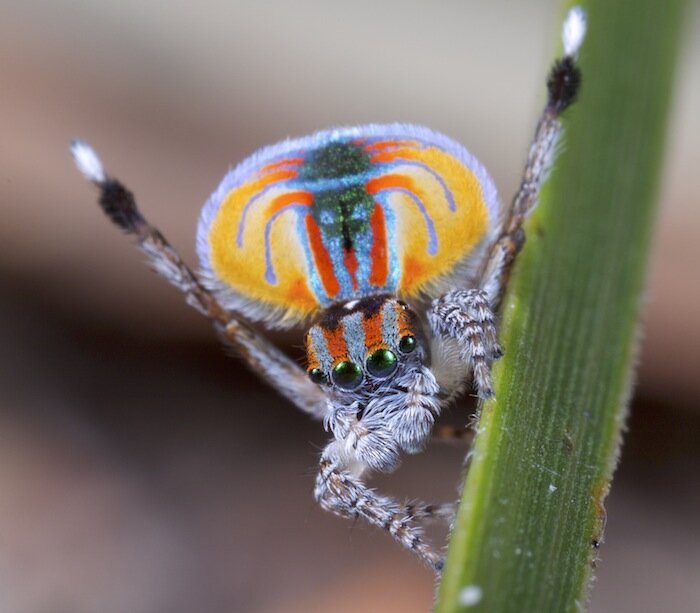Spiders: Friends or Foes?
/Peacock spiders live in Australia, and males like this one dance to impress females. Image by Jurgen Otto.
Aside from entomologists, there aren’t many people who would say that they love spiders. In fact, around of 30% of the US population have some form of arachnophobia, an extreme fear of spiders and their kin. Research suggests that a fear of spiders might be encoded in our DNA, a relic of the past that protected our ancestors from getting a potentially lethal spider bite.
Fortunately, in the modern day, spiders pose little threat to humans. Most people will never have a medically significant spider bite, and there are many ways that spiders are helpful to us instead. In the future, spiders may become even more important to humanity… with the help of science.
Helpful Spiders
One group that spiders are particularly useful to is gardeners. There are very few spiders that eat plant matter, so you don’t have to worry about them nibbling on your lettuce. Instead, spiders eat pest insects that might otherwise damage your crops. A single spider can eat 2,000 insects per year, such as aphids, grasshoppers, caterpillars, leafhoppers, and other common garden pests.
Even though a spider might occasionally eat a bee or butterfly, their benefit far outweighs any harm to local pollinators. Gardeners looking to create a more attractive spider habitat sometimes plant tall plants like sunflowers, giving spiders anchors for their intricate webs. Other spiders prefer to hunt on the ground, and tall grasses or even grass clippings can provide them a happy home. It is even possible to purchase live spiders to release into your garden or field.
Not a gardener? Spiders still might be making your life more pleasant. Indoor spiders eat nuisance insects like flies, cockroaches, and earwigs. Outdoor spiders eat insects that could hurt you or carry disease, like mosquitos. Our productive spider friends also help bring food to the table. Over 600 different species of spiders live in the croplands of the United States, and more spiders there are, the better the crop yields will be. Many organic farmers directly plan for ways to increase spider presence in their fields.
I have been known to get spooked by spiders from time to time, but a world without them would be even more horrifying. Would you rather have a spider in your house, or the hundreds of insects that the spider would eat in a year? It’s up to you to decide, but I know which I’d pick.
Are spiders dangerous?
Some spiders fight crime. Image by John Bauld
It is exceptionally rare that a spider does non-emotional harm to a human. Many spiders have fangs too weak to pierce human skin, and of those that can puncture through, even fewer have venom that causes serious harm to humans. There are only two types of spiders in the United States whose venom produces “medically significant” consequences: Recluse spiders and black widow spiders. Even if these spiders are relatively common in your area, your risk is low. Neither spider is aggressive, and most bites heal without complications.
Overall, spiders kill an average 6 – 7 people per year in the United States. You are more likely to be struck by lightning or win the lottery than be killed by a spider. So, while it may be unpleasant to be startled by a spider in your home, try to relax and remember that the spider is very unlikely to do you any harm.
Image by Tomas Castelazo
Other ways spiders help us
Spiders have a unique biology, and their traits have led to some fascinating scientific discoveries. One subject that has been widely researched is spider silk. Weight for weight, spider silk is stronger in tensile strength than steel, with only one sixth the density. For decades, scientists have experimented with spider silk, testing potential uses and trying to learn how to artificially manufacture it. In the future, spider silk could end up in ballistics armor, athletic, shoes, medical devices, and more. However, useful as spider silk might be, we’d never have enough if we had to wait for spiders to spin it.
To solve the problem of supply, scientists have turned to genetic engineering. Teams have genetically engineered different organisms to produce spider silk proteins, including silk worms, bacteria, yeast, plants, and goats. Once extracted, these proteins can be spun into thread.
So far, this research has only been able to produce a simplified version of spider silk, inferior to the complexity of the real thing. However, research continues, and perhaps someday we’ll all be skiing in spider silk parkas.
Don’t fancy the idea of wearing spider silk as a fashion statement? How about taking some spider venom as medicine instead? For years, scientists across the world have been studying the components of spider venom to use as painkillers. One of the most recent discoveries is a protein from the Chinese bird spider that appears to be highly effective as a painkiller in mice, without significant side effects. Someday, this painkiller could serve as an alternative to the opioids that are commonly prescribed today.
Other potential medical uses for spider venom being investigated include treatments for strokes, cardiac issues, muscular dystrophy, or even Alzheimer’s disease. Other varieties of spider venom are showing promise in early tests of ecofriendly insecticide production.
Love them or hate them, spiders are productive members of our society, helping us grow more food, keep our houses pest-free, and decreasing our pain. Even if you jump when you spot a spider on the wall, maybe in the future you can appreciate them for all the ways they’ve helped us, and continue to do so.
- Kate Dzikiewicz, Science Curatorial Associate and Seaside Center Manager

















